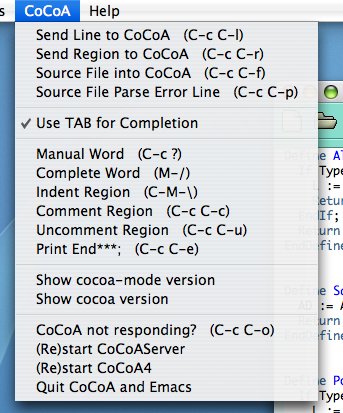CoCoA:Emacs interface: Difference between revisions
From ApCoCoAWiki
added CoCoA menu picture |
slowly updating ("go to parse error line") |
||
| Line 13: | Line 13: | ||
From the menu you can | From the menu you can | ||
* send lines, regions and files to cocoa | * send lines, regions and files to cocoa | ||
* (if you had a parse error after sending a file) | * go to the parse error line (if you had a parse error after sending a file) | ||
* start or restart the CoCoAServer | * start or restart the CoCoAServer | ||
| Line 26: | Line 26: | ||
From a buffer in '''cocoa-mode''' you can select things and "send" them to a cocoa buffer (called <code>*cocoa*</code>) to be evaluated: | From a buffer in '''cocoa-mode''' you can select things and "send" them to a cocoa buffer (called <code>*cocoa*</code>) to be evaluated: | ||
; <code>C-c C-l</code> : execute this line (from any point in the line) | |||
; <code>C-c C-r</code> : execute the selected region | |||
; <code>C-c C-f</code> : execute all this file (from any point in thefile) | |||
; <code>C-c C-p</code> : go to the parse error line (if C-c C-f gave a parse error) | |||
; <code>C-c C-m</code> or <code>C-c ?</code> : call the CoCoA manual for this word (from any point in the word) | |||
They will automatically start CoCoA (if it isn't already running in a <code>*cocoa*</code> buffer). | They will automatically start CoCoA (if it isn't already running in a <code>*cocoa*</code> buffer). | ||
; <code>M-x cocoa</code> : opens a buffer (called <code>*cocoa*</code>) with a running CoCoA | |||
[[Category:CoCoA4]] | [[Category:CoCoA4]] | ||
Revision as of 11:08, 19 October 2005
cocoa-mode
The distribution of cocoa-4.5 includes an emacs/ directory which contains cocoa.el and cocoa.emacs (the settings to be added to your .emacs).
- a friendly CoCoA menu
- automatic indentation
- coloured syntax (in font-lock-mode - default)
- capitalization of keywords (in abbrev-mode - default)
- automatic loading of
wordlist.txtfor dynamic abbrev expansion (M-/orESC /orTAB /)

From the menu you can
- send lines, regions and files to cocoa
- go to the parse error line (if you had a parse error after sending a file)
- start or restart the CoCoAServer
Some key bindings in cocoa-mode
C-c C-e(like in latex-mode) writes the appropriate "End" (EndIf,...)C-c C-c(like in c-mode) comment-region
If the following features do not work you should customize the variable cocoa-executable in cocoa.emacs:
Calling CoCoA
From a buffer in cocoa-mode you can select things and "send" them to a cocoa buffer (called *cocoa*) to be evaluated:
C-c C-l- execute this line (from any point in the line)
C-c C-r- execute the selected region
C-c C-f- execute all this file (from any point in thefile)
C-c C-p- go to the parse error line (if C-c C-f gave a parse error)
C-c C-morC-c ?- call the CoCoA manual for this word (from any point in the word)
They will automatically start CoCoA (if it isn't already running in a *cocoa* buffer).
M-x cocoa- opens a buffer (called
*cocoa*) with a running CoCoA
